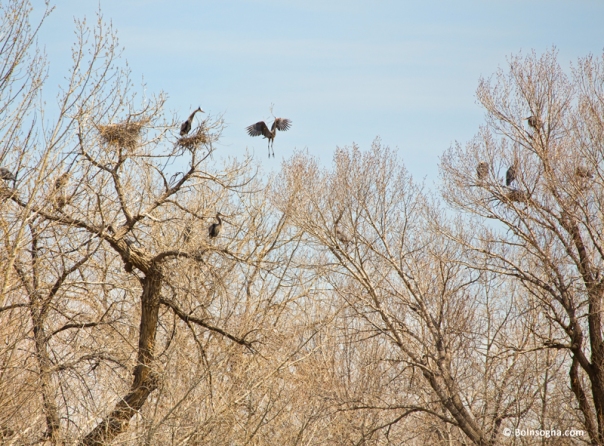Great Blue Heron Nest Building
Spring is such a great time of year for bird watching. One of my most favorites to watch are the Great Blue Herons in Boulder County, Colorado. You can watch these birds for hours as they fly in and out of the nest to the ground grabbing sticks for their nest. An amazing sight to see like watching prehistoric animals in flight.
Here are some great Blue Heron Facts. Hope you enjoy these images and information.
The Great Blue Heron belongs to a large family that includes herons, egrets, and bitterns. This world-wide family has about 60 species. The Great White Heron of Florida is a local color variation of the Great Blue and belongs to the same species.
The Great Blue Heron’s long legs allow it to hunt in deeper water than most other herons and egrets.
Great Blue Herons lay from three to seven eggs, but the usual number is four.
The Great blue Heron has special neck vertebrae that allow the neck to curl into an “S” shape, and its structure allows a lightning-quick strike at prey. In flight the neck is folded back into the S-shape and the legs are stretched out behind them.
Great Blue Herons can hunt day and night thanks to a high percentage of rod-type photoreceptors in their eyes that improve their night vision
Great Blue Herons typically breed in colonies containing a few to several hundred pairs. Nest building begins when a male chooses a nesting territory and actively displays to attract a female. The large nest is usually built high up in a tree. The male gathers sticks for the female who constructs a platform nest lined with small twigs, bark strips, and conifer needles. The female lays 2-6 pale blue eggs, then both parents incubate them for 25-29 days (4 weeks) until the young hatch. The parents bring food to young at the nest for two months before the young can fly and continue feeding the birds for a few weeks after fledging the nest.
Great Blue Herons look enormous in flight, with a six-foot wingspan.
Both parents take turns incubating the eggs for 4 weeks.
In flight, a Great Blue Heron usually holds its head close to its body with the neck bent.
The young can first fly at about 60 days old.
The Great Blue Heron is the largest and most widespread heron in North America. Great blue herons size range from 3.2 to 4.5 feet and a wide wingspan of 5.5 to 6.6 feet making them a joy to see in flight. They can cruise at some 20 to 30 miles an hour. The average life span in the wild is 15 years.
Herons get their name from their grey-blue feathers. Blue herons will nest in groups from 5 to 500 nests in one colony. A colony of herons is called a” heronry”. They lay three to six pale blue eggs and raise one brood per year. A heron may abandon the nest if it is disturbed by humans. Other predators include bald eagles, great horned owls, hawks, bears and raccoons.
Colorado Fine art wildlife photography images by James Bo Insogna (C) – All Rights Reserved.
Please feel Free to share our links, with Family or Friends who may also enjoy them.
Striking Fine Art Photography International Gallery
If you like my Art Gallery, please spread the word and press the Pinterest, FB, Google+, Twitter or SU Buttons!
Thank you!
Bo Insogna
Recent Striking Fine Art Photography Prints and Images:
Colorado Longs Peak Stargazing
When One Door Closes Another Opens
Golden Beams Of Sunlight Shining Down
Colorado Scenic Landscapes Views Video
Posted on April 6, 2014, in Animals, Birds and tagged behavior, bird, birds, blue herons, Colony, conservation, feeding, great blue heron, habitat, herons, James Insogna, Nature, nest, nesting, outdoors, photographs, trees, Wildlife. Bookmark the permalink. 17 Comments.



Reblogged this on william patrick photo.
Thank you!
Reblogged this on rebloggobbler.
Wow so many in the trees!
Thank you!
😀
Thanks!
🙂
Pingback: Great Blue Heron Nest Building | shootplex
Pingback: Colorful Cloud to Cloud Lightning Thunderstorm 27 | Striking Photography by Bo blog
Pingback: Lightning Tree Silhouette 38 | Striking Photography by Bo blog
Pingback: Lightning Tree Silhouette Black and White | Striking Photography by Bo blog
Pingback: North East County Sunset | Striking Photography by Bo blog
Pingback: Lonely Tree On The Boulder County Plains | Striking Photography by Bo blog
Pingback: Turbo Charged Country Sky | Striking Photography by Bo blog
Pingback: Early Morning Turbo Country Sky | Striking Photography by Bo blog
Pingback: Rural Turbo Country Sky | Striking Photography by Bo blog